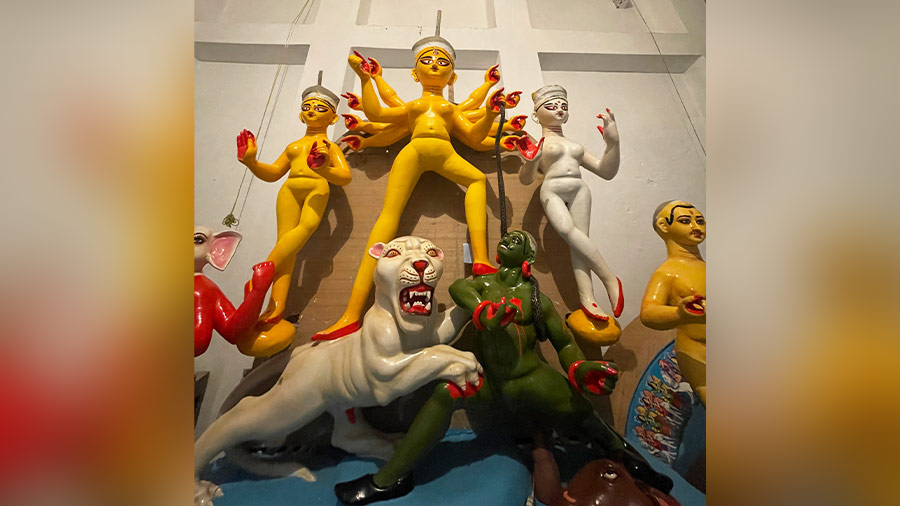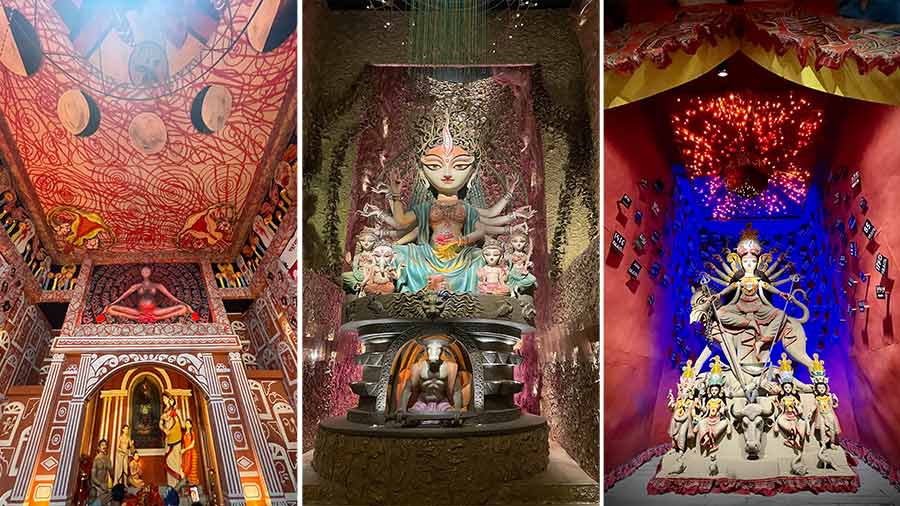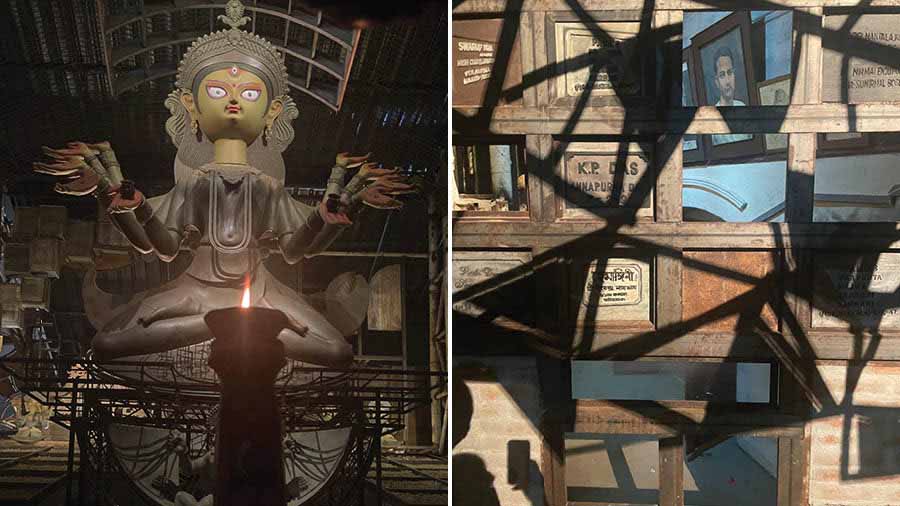Continued from here.
I visited a 250-year-plus temple on 18/4 Akrur Dutt Street in Bowbazar (lane at a diagonal right if you were standing with your back to Hind Cinema in central Kolkata).
The temple was built by the legendary Akrur Dutt – little of him is known in the publicly accessible domain – and presumably must have been at one end of a sprawling estate that stretched from Wellington Square to Akrur Dutt Lane (his descendant Samit tells me that the land owned by the Dutts extended from Wellington to BB Ganguly Street at the height of their financial power in the 18th century, which must have made it one of the richest Indian families in the city).
The eighth generation Dutt tells me something on two separate occasions that has remained with me: ‘The protima cost is perpetually rising and now costs around Rs 44,000. I don’t know for how many years one will be able to sustain the family pujo tradition.’
Akrur Dutt – where the story begins – was born into a poor family in Pandua district, in 1722. A family humiliation – he was dismissed as a ‘waster’ – compelled him to leave home in the 1740s. Akrur passed villages without food before he reached Bistupur where an unusual reality awaited him: a zamindar's widow, who he obviously did not know, reached out for help. Her estate employees had fled fearing a Maratha invasion.
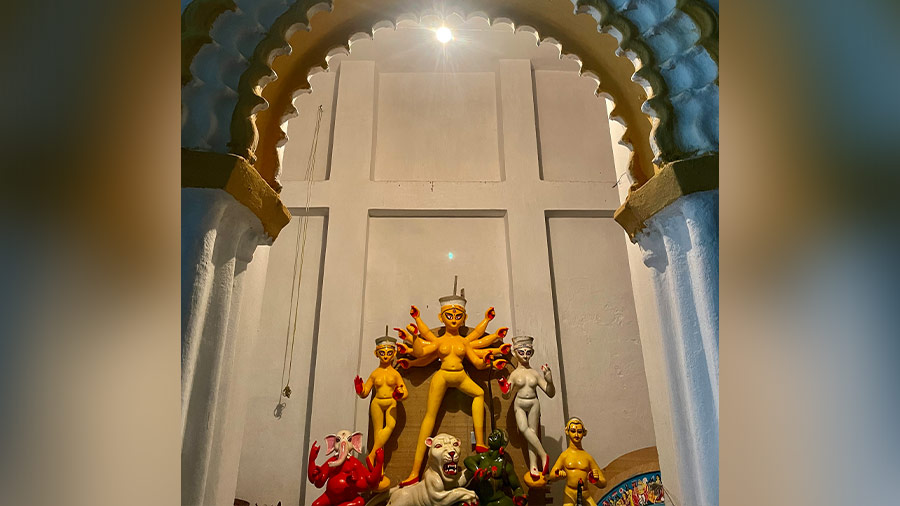
‘The protima cost is perpetually rising and now costs around Rs 44,000. I don’t know for how many years one will be able to sustain the family pujo tradition,’ says Samit Dutt, an eighth-generation family member’
When the ‘borgis’ did arrive with burning torches at night, they encountered a sleeping Akrur at the estate gate. Akrur presented an innocent case: he was a stranger, he was resting for the night and he would leave at daybreak. The invaders considered him to be of no value: they entered, looted and left. The morning after, Akrur made a decisive move that would define generations after him: he ‘extracted’ the two widows from their underground hide-out. For his quick thinking, he was presented a ‘five-faced couch-she, guineas from Akbar's period, seven golden bricks and a salgram shila of Raj-Rajeswar’.
Akrur entered a pre-Plassey Calcutta with precious capital to trade with merchants. He forged a friendship with a Pritiram Das who was not only a resident of Janbazar but who among other things was to become decades later father-in-law of a young lady called Rashmoni. Akrur and Pritiram prospered in what would be referred to as ‘shipchandling’. A line in Akrurbabu’s biography (written in 1995 by Haradhan Dutt, grandson of Kanai Lal Dutt, youngest great-grandson of Akrur Dutt) indicates that he held the sole – I read the word twice – contract for handling the East India Company's cargo (inward and outward). The migrant must have been one of the quickest ‘making good’ stories in the Calcutta of Clive and Hastings.
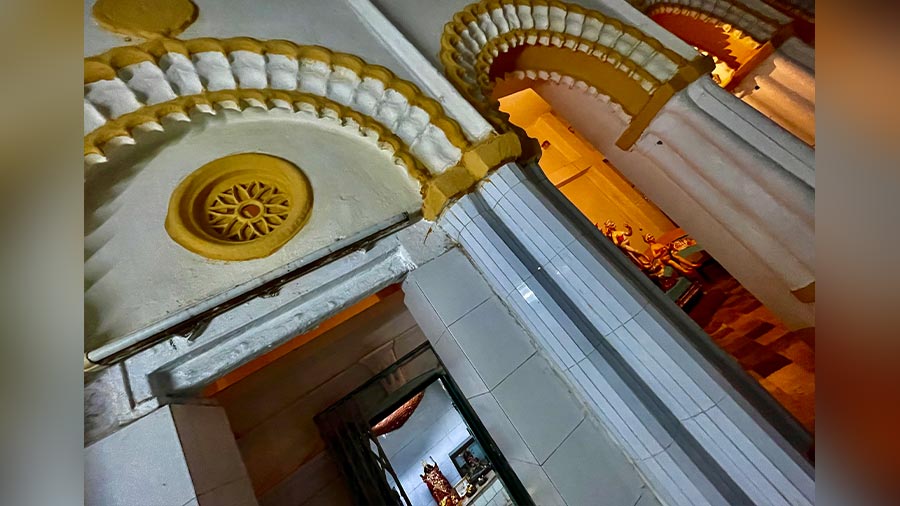
The ‘thakur dalan’
Akrur settled in the Malanga/Dingabhang area of Town Calcutta – marked on the north by Bowbazar, south by Dharamtalla Street, west by Chandni Chowk and east by the Dingabhanga Canal (later filled and renamed Creek Row). It is quite possible that a dense cluster of straw huts marked the area; the open tracts comprised the cultivation of paddy, tobacco, banana and vegetables. It is there that Akrur – in his forties – invested in a large building that has been described as follows: ‘Frontal portion has a big courtyard and thakur dalan (place of worship) for holding important religious festivities. This segment is followed by four other portions (mahals) consisting of more than 100 rooms with inter-connection in each floor up to the nearest portion. A separate building overlooking the main street and Wellington Square (re-named Subodh Mallik Square) for accommodating the family library and a large parlour house (baithakkhana bari) was perhaps built much after Akrur’s death comprising stables, shops, godowns, coach house, tank, garden etc.’
More than 100 rooms. Fittingly. Because by the time Akrurbabu passed away at 87 – more than twice the average age in early 19th century Calcutta – he was acknowledged as the undisputed ‘shipping and sloop’ merchant of the city (sloop described as a single-masted sailing vessel with fore-and-aft rigging). The visionary didn’t just control commodities or products; he controlled the vessels instead.
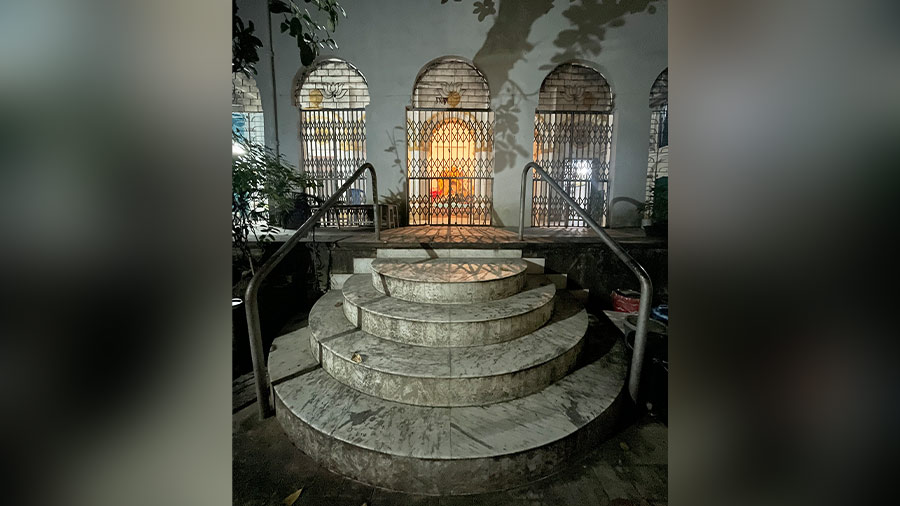
The family temple (also below)
Just when one presumes that it would all have been an Aurangzeb-like collapse thereafter, something interesting transpired: the descendants opened a line of business with American traders of Salem, Massachusetts. The brother, sons and nephews did their bit but the individual who breathed life into the genealogical tree was Rajinder – scholar, bibliophile, merchant, physician, educationist, performer and humanist. He was a renaissance man at a renaissance time in a renaissance region; he spoke French, Latin, Greek, Italian and English – and if this were not enough, studied Hebrew to appreciate Christianity.
An Englishman, Norton, described the Durga Puja at the Dutt ancestral house following an invitation by Rajinder in 1849. “The open (courtyard) was covered with a carpet and hung with lights, which gave it brilliance of a ball room [this is pre-electricity Calcutta] … I have described half the decorations of the court, you will easily imagine that the effect was brilliant and striking.” Norton added: “Along each side of the lane (leading to the house) were brilliantly painted clay figure modelled from pictures, by native and many of them were from Shakespeare: there were Hamlet and Ophelia, King Lear and Cordelia. Ann of Geiers, The Lady of the Lake and many others. The lane was brightly lighted and filled with a crowd of dark and variously dressed spectators.”

The fourth evening of the festival (possibly Dashami) was spent in entertaining European friends when there were no Hindu rituals to be performed. Rajinder remarked, “Christian ministers disapproved of their Parish’s exposure to Hindu rituals and were afraid... to see their flocks going astray.”
Rajinder may have been described as a ‘character’. He performed David Hare’s last rites as per Hindu shastras in Gaya; he co-started a charitable allopathic dispensary at his residence (and built up a sizable following including the Jorasanko Tagore family); was described as the ‘father of homoeopathy in India’; he was a business person cum medical professional who used his position as the former to further interests as the latter (delivering free medicines and diet); he treated Sri Ramakrishna in the latter’s last years (‘brought great relief to the Master for more than a fortnight’); he presented Sri Ramakrishna with a pair of velvet slippers that is now worshipped at Belur Math.
Rajinder started the Dutt Family Library, possibly the first such institution to be promoted by an Indian in Calcutta, “which was in no way inferior to the Calcutta Public Library” (later renamed Imperial Library and National Library). The Orientalist Dr Fitz Edward Hall wrote in the New York Nation: "Even before Rajinder was 30, his library was by far the largest and the most valuable of any private person in Calcutta and it went on growing to the last. Every volume that he purchased, he dipped into for at least one hour or two before consigning it to his shelves.”
This column represents a departure from my earlier ones. It does not celebrate; it mourns. I would recommend that you take a walk into Akrur Dutt Lane to see why. The mandir that he built stands but the thakur dalan that must have been one of the most spectacular in the city has now been encroached upon. Where once stood chandeliers and rooms you will now find someone’s residence where a resident has just switched on a cricket match on television.
The Savitri Library (the name by which the Dutt Family Library was formally recognised) wound down by the first decade of the last century; the annual meetings became infrequent; the books were mothballed; there came a day when 2250 volumes were handed over to Bangiya Sahitya Parishad.
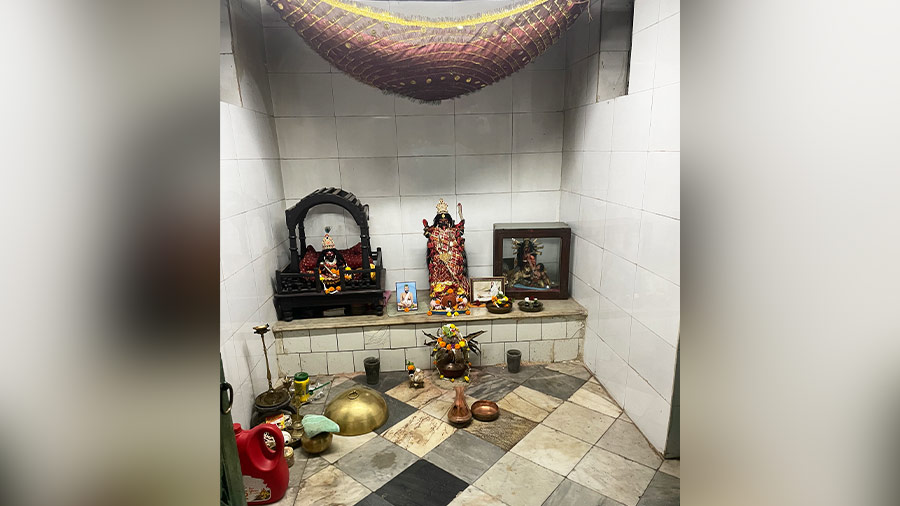
Rajinder Dutt wrote hundreds of letters, commissioned a number of statues and owned large real estate. The artefacts have been scattered; the real estate has shrunk to a fraction (the temple). What remains is what he sent his American business counterparts. A marble image of Gajalakshmi (Goddess of wealth) is showcased in the Peabody Museum, Salem, around 173 years after it had been dispatched; three life-like clay representations of Calcutta banians (Rajinder Dutt, Raj Kissen Mitter and Doorgapersaud Ghose) by Krishnanagar potters are showcased for the public; more than 21 letters by Kalidas Dutt and Rajinder Dutt have been preserved at the Essex Institute Library, Salem. The glory of the Dutts – of whatever remains – has been preserved by a people who have no idea of who they were and what they did.
Which brings me to the gift to a young Akrur by the widows in gratitude. The Raj-Rajeshwar statue stands in a corner room of the family temple in Bowbazar, nearly 280 years after it had been given. In a sense, this (and the temple) is largely all that remains of a family that once “controlled” the waters of the Ganges. Which brings me to the protima, the cost and the apprehension that the Durga pujo of a family – game makers in the social, educational and mercantile nineteenth century Bengal – could be wound down into anonymity eight generations after the founder.
The next time you walk this slice of Bowbazar, tread gently on the bitumen. In memory of what existed a couple of hundred years ago and in gratitude for what one family attempted.
